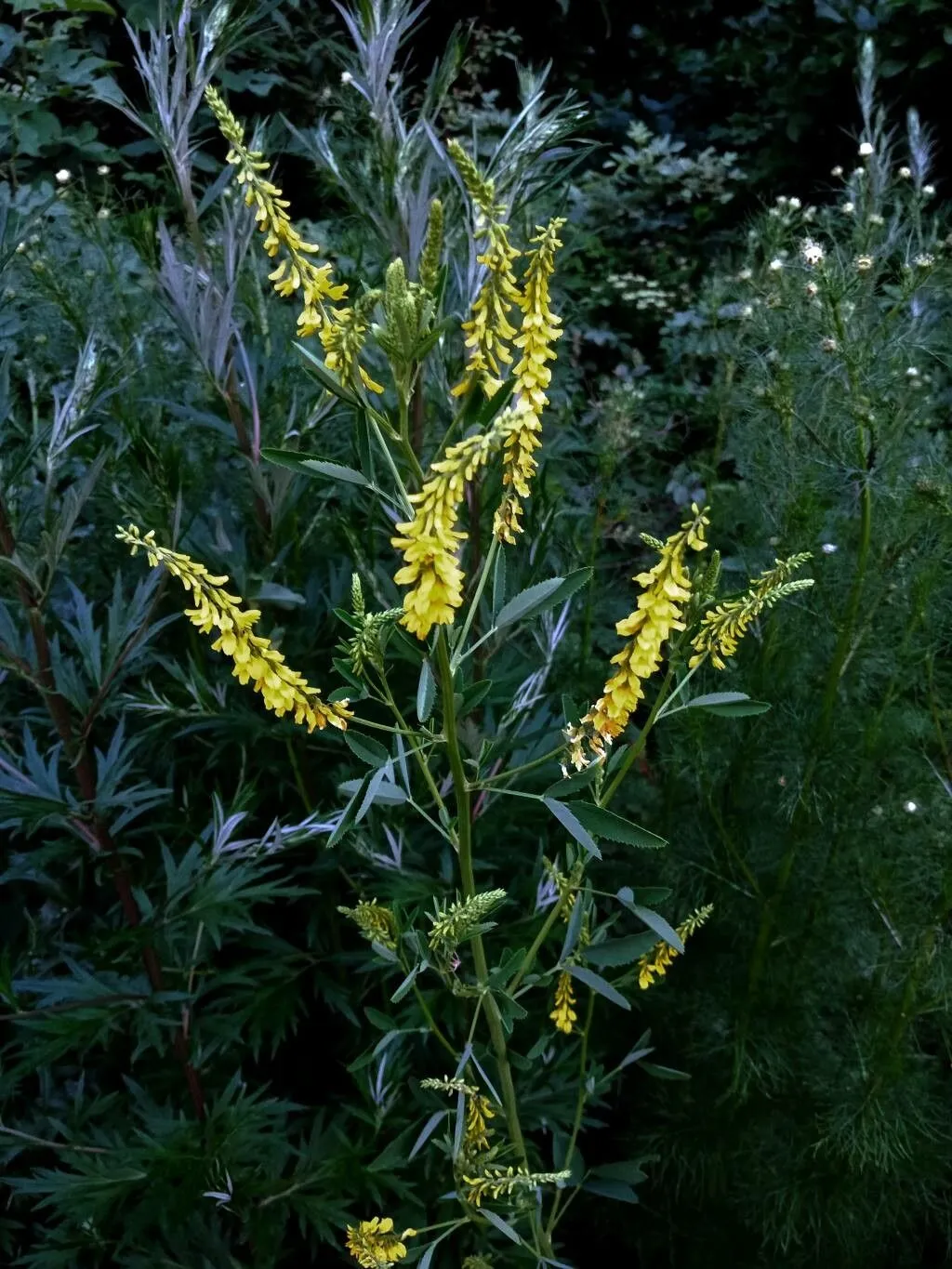
Author: Pall.
Bibliography: Fl. Franç. 2: 594 (1779)
Year: 1779
Status: accepted
Rank: species
Genus: Melilotus
Vegetable: False
Observations: Europe to W. Himalaya and Arabian Pen.
Yellow sweetclover, scientifically known as Melilotus officinalis, is a noteworthy member of the Fabaceae family. This plant was first recognized and described by Pall. and referenced in the Flora Francica, published in 1779.
This versatile species is native to a widespread region encompassing Europe, stretching all the way to the western Himalayas and the Arabian Peninsula. Its adaptability allows it to thrive in a variety of environments, and it is often found flourishing in wild meadows, along roadsides, and in disturbed lands where other vegetation may struggle.
Yellow sweetclover is characterized by its tall, branching stature with slender stems. The plant’s trifoliate leaves are composed of three finely serrated leaflets, and during its blooming period, it produces racemes adorned with small, fragrant yellow flowers. These blooms are not only attractive visually but also serve as a valuable source of nectar for pollinators like bees and butterflies.
The plant has diverse applications, ranging from its use in agriculture as a valuable cover crop and as a natural means for soil improvement due to its nitrogen-fixing capabilities, to its use in traditional medicine. Historically, yellow sweetclover has been utilized for its purported medicinal properties, including its use in poultices and infusions to treat various ailments.
In summary, Melilotus officinalis stands out not only for its ecological benefits and role in supporting wildlife but also for its historical and medicinal significance. Its wide distribution and versatility make it an important plant both in natural ecosystems and agricultural practices.
Eng: common melilot, cornilla real, field melilot, ribbed melilot, sweetclover, yellow melilot, yellow sweet-clover, yellow sweetclover, yellow trefoil
Deu: gewöhnlicher steinklee, echter steinklee, gelber steinklee
Dan: mark-stenkløver
Spa: cornilla real, meliloto amarillo, trébol de olor
Swe: gul sötväppling, sötväppling, äkta sötväppling
Ita: meliloto giallo
Fra: mélilot jaune, mélilot officinal, trèfle d’odeur jaune
Por: trevo-cheiroso
Nno: legesteinkløver, lækjesteinkløver
Nob: legesteinkløver
Sme: miehtaluovvar
En: Yellow sweetclover, Ribbed Melilot, Yellow Sweet-Clover, Sweetclover, Common Melilot, Sulfinâ, Yellow Melilot, Yellow Sweet Clover, Common Yellow Melilot, Corn Melilot, Medicinal Sweetclover, Cornilla real, Field melilot
Ar: أكليل الملك, إكليل الملك, الحندقوق, حندقوق
Hy: Իշառվույտ դեղատու
Az: Dərman xəşənbülü
Ba: Ҡандала үләне
Eu: Itsabalki arrunt
Be: Баркун лекавы
Bg: Жълта комунига
Ca: Melilot
Ce: Дарбане аларт
Zh: 草木樨, 黄香草木樨
Cs: Komonice lékařská, Komonica lekárska
Da: Mark-stenkløver
Nl: Akkerhoningklaver, Citroengele honingklaver
Et: Kollane mesikas
Fi: Rohtomesikkä
Fr: Mélilot des champs, Mélilot diffus, Tèefle d’odeur jaune, Trèfle d’odeur jaune, Trèfle de cheval, Trèfle des mouches, Melilot officinal, Mélilot jaune, Mélilot officinal, Melilot jaune, Mélilot élevé
Gl: Meliloto
De: Echter Steinklee, Gelber Steinklee, Gewöhnlicher Steinklee, Gebräuchlicher Honigklee, Kleeblume
El: Μελίλωτος
Gu: ઝરેર
Hu: Orvosi somkóró
Ga: Crúibín cait
It: Meliloto, Meliloto comune, Melilotus officinalis, Melilotoodoroso, Erba Vetturina
Kk: Сары түйежоңышқа
La: Trifolium melilotus
Lt: Geltonžiedis barkūnas, Jondobilis
Mk: Обична комуника
Mn: Эмийн хошоон
No: Legesteinkløver
Nb: Legesteinkløver
Nn: Lækjesteinkløver
Fa: اکلیل الملک, اکلیلالملک, بسنگ, شاه افسر, شاه بسه, شاهافسر, ناخنک, یونجه زرد
Pl: Nostrzyk lekarski, Nostrzyk żółty
Pt: Meliloto, Meliloto-amarelo, Trevo-de-cheiro.
Ro: Sulfină
Ru: Донник желтый, Донник жёлтый, Донник лекарственный
Sk: Komonica lekárska
Es: Trébol real, Navadna medena detelja, Meliloto amarillo, Trébol de color amarillo, Meliloto Officinale
Sv: Gul sötväppling, Rohtomesikkä
Zh-tw: 黃香草木樨
Tg: Асалришқа
Zh-hant: 黃香草木樨
Tr: Sarı taş yoncası
Uk: Буркун лікарський, Конюшина лікарська
Cy: Yr wydro resog, Gwydro, Gwydro Rhesog, Meillionen y Ceirw, Mel y Ceirw, Pysen y Ceirw
Taken Oct 4, 2020 by Cervellino Angélica (cc-by-sa)
Taken Jun 23, 2021 by Tobias Hejtmann (cc-by-sa)
Taken Jul 17, 2022 by selber pflanzen (cc-by-sa)
Taken Jun 10, 2017 by Yoan MARTIN (cc-by-sa)
Taken Jul 31, 2021 by Clara Wagner (cc-by-sa)
Taken Jul 17, 2022 by selber pflanzen (cc-by-sa)
Taken Jul 15, 2022 by Andrzej Konstantynowicz (cc-by-sa)
Taken Jul 31, 2021 by Clara Wagner (cc-by-sa)
Taken Jul 31, 2021 by Clara Wagner (cc-by-sa)
Taken Jun 27, 2022 by Blue Bottle (cc-by-sa)
Taken Oct 26, 2022 by Trap Hers (cc-by-sa)
Taken Jun 10, 2017 by Yoan MARTIN (cc-by-sa)
Taken Jul 4, 2019 by Georg Lanzl (cc-by-sa)
Taken Jul 17, 2022 by selber pflanzen (cc-by-sa)
Taken Jun 27, 2022 by Blue Bottle (cc-by-sa)
Taken Jun 5, 2022 by Clovis De Guesles (cc-by-sa)
Taken Jun 24, 2020 by Lena Villeneuve (cc-by-sa)
Taken Oct 30, 2022 by Jean-Louis PASTEUR (cc-by-sa)
Taken Feb 21, 2017 by Yoan MARTIN (cc-by-sa)
Taken Feb 21, 2017 by Yoan MARTIN (cc-by-sa)
© copyright of the Board of Trustees of the Royal Botanic Gardens, Kew.
© copyright of the Board of Trustees of the Royal Botanic Gardens, Kew.
© copyright of the Board of Trustees of the Royal Botanic Gardens, Kew.
Taken May 22, 2022 by stéphane COLLE (cc-by-sa)
Taken May 8, 2003 by EOL − Steven J. Baskauf (cc-by-nc-sa)
Taken May 24, 2021 by Савченко Никита (cc-by-sa)
Taken Jun 10, 2017 by Yoan MARTIN (cc-by-sa)
Taken Jul 17, 2022 by selber pflanzen (cc-by-sa)
Taken Jun 16, 2020 by Jean Burger (cc-by-sa)
Taken Mar 13, 2021 by Lupus Nadine (cc-by-sa)
Taken Dec 8, 2002 by Maxime Santer (cc-by-sa)
Taken Jan 1, 1900 by EOL − Encyclopedia of Life (cc-by-nc)
Taken Aug 31, 2019 by Clark Brenzil (cc-by-sa)
Growth form: Single Crown
Growth habit: Forb/herb
Growth rate: Rapid
Ph maximum: 8.2
Ph minimum: 6.5
Light: 8
Atmospheric humidity: 4
Soil nutriments: 5
Family: Myrtaceae Author: (F.Muell.) K.D.Hill & L.A.S.Johnson Bibliography: Telopea 6: 402 (1995) Year: 1995 Status:…
Family: Rubiaceae Author: Pierre ex A.Froehner Bibliography: Notizbl. Bot. Gart. Berlin-Dahlem 1: 237 (1897) Year:…
Family: Sapindaceae Author: Koidz. Bibliography: J. Coll. Sci. Imp. Univ. Tokyo 32(1): 38 (1911) Year:…
Family: Asteraceae Author: A.Gray Bibliography: Pacif. Railr. Rep.: 107 (1857) Year: 1857 Status: accepted Rank:…
Family: Fabaceae Author: Medik. Bibliography: Vorles. Churpfälz. Phys.-Ökon. Ges. 2: 398 (1787) Year: 1787 Status:…
Family: Aspleniaceae Author: (Cav.) Alston Bibliography: Bull. Misc. Inform. Kew 1932: 309 (1932) Year: 1932…